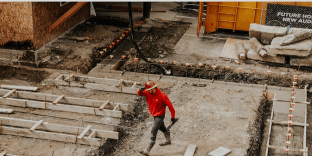
BIM and Robotics Transform Wall-to-Door Conversions
The construction industry stands on the brink of a technological revolution. The integration of Building Information Modeling (BIM) with automated construction robotics is not just an innovation; it’s a transformative approach that redefines the traditional wall-to-door conversion process. This article delves into the intricacies of this integration, exploring how it enhances precision, efficiency, and sustainability in construction projects from wall-to-door conversions.
What Is BIM and How Does It Change the Game?
Building Information Modeling (BIM) is more than just a 3D design tool; it’s a comprehensive process that facilitates the creation, management, and sharing of the digital representations of physical and functional characteristics of places. BIM models are files (often but not always in proprietary formats and containing proprietary data) which can be extracted, exchanged, or networked to support decision-making regarding a built asset.
But how does BIM change the game in wall-to-door conversions? It allows for meticulous planning and visualization, enabling architects, engineers, and contractors to foresee potential structural issues and plan for them accordingly. Advanced BIM software can simulate the structural impact of creating new doorways and suggest the best methods for reinforcement, ensuring that the architectural integrity is uncompromised.
How Are Automated Construction Robotics Shaping the Future?
The advent of automated construction robotics heralds a new era for the construction industry. These robots, guided by precise BIM data, can perform exact cuts and demolitions, maintaining the structural integrity of the building while creating new door openings. But their benefits extend beyond precision. We at Load Bearing Wall Pros haven’t quite hired our first robot employee – but it looks like there are a number of benefits to both you the homeowner and our business that we may be rethinking this in a few short years.
Efficiency: Robots can work continuously without the need for breaks, significantly speeding up the construction process. Safety: Robotics reduce the need for human workers to perform dangerous tasks, thereby decreasing the risk of on-site injuries. Cost-effectiveness: Over time, the use of robotics can lead to cost savings by reducing labor costs and minimizing waste.
What Innovative Materials Are On the Horizon for Homeowners?
In the context of wall-to-door conversions, the choice of materials plays a pivotal role in the project’s success. While not widely available in all markets at the moment, we’re keeping an eye on the pricing and feasibility of these solutions for future projects. Let’s explore the advanced materials that are not only enhancing the functionality of wall-to-door conversions but also redefining industry standards for durability and efficiency:
Self-Healing Concrete: This futuristic material contains bacteria that produce limestone when activated by water, effectively sealing cracks before they can expand. The inclusion of self-healing concrete in the conversion process not only extends the lifespan of the structure but also reduces maintenance costs and enhances overall safety.
Smart Glass: Also known as switchable glass, this material transitions from opaque to transparent with the application of an electrical current. Its use in door installations offers dynamic control over privacy and light, contributing to energy savings by reducing the need for artificial lighting and heating.
Composite Materials: The development of new composites has provided the construction industry with materials that are not only strong and lightweight but also resistant to environmental factors such as corrosion and UV radiation. For doors, this means a product that withstands the test of time and maintains its aesthetic qualities, even under harsh conditions.
Aerogel Insulation: Aerogel, the lightest solid material known, provides exceptional thermal insulation properties. When used around door frames, it can significantly improve the building’s energy efficiency, leading to a greener footprint and lower energy bills.
Shape Memory Alloys: These alloys can return to their original shape after deformation, offering unique opportunities for adaptive door frames that can self-adjust in response to temperature changes, ensuring a perfect seal throughout the year.
By incorporating these advanced materials into wall-to-door conversions, construction companies like ours will one day offer cutting-edge solutions that are durable, efficient, and visually appealing, setting a new standard for modern construction practices.
Why Is Sustainability Important in Wall-to-Door Conversions?
Sustainability is no longer a buzzword, it’s a becoming a smart business decision in construction. To us, this means minimizing the environmental impact of projects per the desires of our younger customers. Wall-to-door conversions will one day be made more sustainable by:
Recycling Materials: Utilizing recycled materials not only conserves natural resources but also decreases the energy consumption typically associated with manufacturing new products. This approach aligns with global efforts to reduce waste and promote a circular economy.
Energy Efficiency: Implementing energy-efficient methods throughout the conversion process, from the use of power tools to the robotics involved, can lead to substantial energy savings. This is particularly important as the construction sector is a significant energy consumer.
Waste Reduction: Minimizing waste not only lessens environmental pollution but also cuts down on the costs associated with waste disposal. Planning for waste reduction involves careful resource management and innovative construction techniques that maximize material usage.
Incorporating these sustainable practices into wall-to-door conversions demonstrates a company’s commitment to environmental stewardship and positions it as a leader in the movement towards more sustainable construction methodologies.
How Does Technology Ensure Worker Safety and Compliance?
Technology plays a crucial role in ensuring worker safety and compliance in the construction industry, particularly during complex processes like wall-to-door conversions. Here’s an expanded look at how we think new technologies will become more commonplace in our projects.
Drones for Site Inspections: Drones offer a safe and efficient means to inspect construction sites from above, reducing the need for workers to enter potentially dangerous areas. Equipped with cameras and sensors, drones can quickly identify structural issues, misplaced materials, or any other potential hazards that could compromise worker safety.
Augmented Reality (AR) for Training: AR technology provides an immersive training experience, allowing workers to practice the steps involved in wall-to-door conversions in a controlled, virtual environment. This hands-on approach helps workers understand the complexities of the task without the risks associated with on-site training.
Wearable Technology: Wearable devices can monitor vital signs, detect falls, and even alert workers if they enter hazardous zones. These devices ensure that workers are constantly monitored for safety and can provide immediate assistance in case of an emergency.
Machine Learning for Compliance: Machine learning algorithms can analyze vast amounts of data to ensure that construction practices comply with the latest safety regulations. By identifying patterns and predicting potential compliance issues, technology can help prevent accidents before they occur.
Finalizing Worker Safety and Compliance: By integrating these technological advancements, construction companies can create a safer work environment and ensure compliance with safety regulations. This not only protects the workers but also enhances the overall efficiency and reputation of the company in delivering high-quality, safe construction services.
The future is exciting for the construction world. And as the materials and strategies mentioned in this article become less expensive and more sensible for the broader residential world, Load Bearing Wall Pros will be the first to implement for your wall-to-door, column removal or load bearing wall removal projects.


